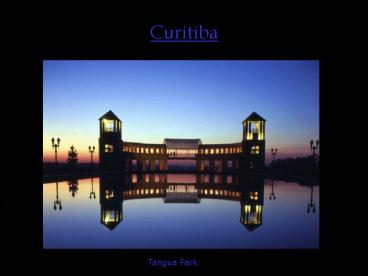Curitiba - PowerPoint PPT Presentation
1 / 14
Title:
Curitiba
Description:
http://www.curitiba.pr.gov.br/pmc/curitiba/historia/images/pintura.jpg ... of the province of Paran , would promote and encourage the construction of ... – PowerPoint PPT presentation
Number of Views:771
Avg rating:3.0/5.0
Title: Curitiba
1
Curitiba
http//www.embratur.gov.br/0-catalogo-imagens/dest
inos-parana/PR_curitiba_06_p.jpg
Tangua Park
2
Foundation and first steps of the city
Curitiba was founded on the 29 of March of
1693 by the captain Matheus Martins Leme. The
first name of the settlement which will later be
called Curitiba with the status of villa was Vila
Nossa Senhora de Luz dos Pinhais. With the visit
of Raphael Pires Pardinho in 1721, Curitiba
became a city.
http//www.curitiba.pr.gov.br/pmc/curitiba/histori
a/images/pintura.jpg
Image of the villa Nossa Senhora de Luz dos
Pinhais
Pardinho was probably environment of the city,
and with his effort, a long tradition now
internationally recognized of a careful urban
planning intertwined with environmental concerns
became established. In those times, Pardinhio
determined that inhabitants must have a special
treatment with the surrounding environment.
3
Early Urban Planning
The now internationally recognized tradition of
urban planning of Curitiba has a long history.
Only two years after its foundation, the city was
already the object for the first studies to
organize the initial settlement. Curitiba needed
public works and a redefinition of its urban
planning. Zacharias de Goes Vasconcellos, by that
time the one of the first authorities that
worried about the president of the province of
Paraná, would promote and encourage the
construction of schools, theaters and clubs. For
this end, in 1855 the French engineer Pierre
Taulois was hired as the general inspector of
land measurement of public lands.
4
Plan Agache
Several measures taken since the last decades of
the nineteenth century and the beginnings of the
twentieth centuries were the initial steps taken
to organize the city with a special consideration
towards appropriate water services and sewages as
well as to the construction of parks and avenues
to increase the life quality in the city.
http//www.curitiba.pr.gov.br/pmc/curitiba/histori
a/images/agache.jpg
Plans and designs of the Plan Agache elaborated
between 1941-1943
The decade of the forties saw the elaboration of
the urbanistic plan for Curitibá. This urban
design called Plan Agache after the French
architect responsible for its development,
prioritizing the cleaning of the city as well as
the reduction of congestion and the constructions
of centers for the development of social and
commercial life.
5
Curitiba-Immigration
The nineteenth century also saw the arrival of
immigrants to the city. The principal countries
of origin of this wave of immigration were Italy,
Poland, Ukraine, Germany, Swiss, Japanese and
Lebanese. The city has honored the contribution
of these colonies to its own development by
building memorials that recreate the
architecture, landscape and traditions of each
nation.
Polish memorial
Ukrainian memorial
Japanese memorial
6
Arab memorial
Images of the Arab Memorial, in honor of the the
Arab colony in Brazil. The memorial holds a
public library with a significant amount of
titles related to the Arab heritage, with
internet access.
7
Bosque Alemão-German Park
BOSQUE ALEMÃO , inaugurated in 1996
8
Curitiba innovative urban solutions
During the decade of the eighties, the challenge
was to make more accessible the basic services
for an increasing population of 1,600,000
inhabitants.
http//www.viaje.curitiba.pr.gov.br/Abav/saladeimp
rensa/fotos/transpo/image/transp10.jpg
Images of Curitiba Transport System
This context saw the creation of an
environmentally sensitive network for integral
transportation in which any citizen could move to
any part of the city using a single ticket,
making it the more effective system of collective
transportation in the country. Nowadays, this
model of transportation has been exported to
other major cities in South America and Africa.
9
Curitiba, the city and metropolitan area
http//www.curitiba.pr.gov.br/pmc/agencia/fotos/ru
a_xv_30anos/image/rui_barbosa_depois3.jpg
By the year 2000, Curitibá arrives as the fourth
most powerful economic force in Brazil. Indeed, a
key element in this situation has been the citys
articulation to its metropolitan region. The city
not only extends its services like the one of
Public Transportation throughout the region, but
also offers permanent consultancy to the
municipal governments of the region.
10
Ecological capital
Image of the Opera of Arame, inaugurated in 1992
Tangua Park, inaugurated in 1996
Curitiba completed 300 years in the path of
creative and novel solutions leading the vanguard
or urban planning in a worldwide level. It also
has the largest portion of green areas per
inhabitant that makes her to be considered the
ecological capital of Brazil.
11
Rua 15/15th Street
http//www.curitiba.pr.gov.br/pmc/agencia/fotos/ru
a_xv_30anos/image/rua_xv_depois5.jpg
12
Images of Curitibá
Rua 15/15th Street
13
Images of Curitibá
San Francisco Plaza
Rua 24 Horas, Curitiba.
14
Sources
- Government of the City of Curitibá
- Website www.curitiba.pr.gov.br
- Tourism Office of the City of Curitibá
- Website www.viaje.curitiba.pr.gov.br































